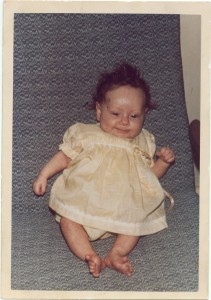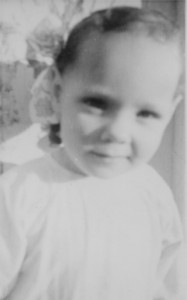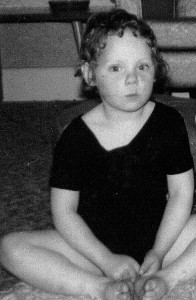Visual Perceptual Disorders in children with autism
The same thing can be seen here at age 4:
or in this one at age 6:
Or all visual processing has gone off line so I look more like a blind child:
The visual perceptual issues I experienced before dietary interventions in my 20s and tinted lenses in my 30s included:
* processing faces, bodies, rooms, objects bit by bit
* difficulty recognising objects unless they were being used (action lending meaning to the visual)
* difficulty recognising known objects unless in expected placement (lending meaning from location)
* visual distortions with the floor
* visual distortions with distance
* random shifts in background/foreground (shifts from positive to negative space and back)
* inability to recognise faces, even my own in a mirror (thought it was someone else)
* reliance on being found because I couldn’t recognise others
* high emphasis on kinesthetic (touch/movement/mouthing), auditory (tapping), smell for recognition
* filling in social, emotional, communication gaps with kinesthetic (physical) self entertainment
* repeated (compulsive) dropping, tossing, spinning of objects (3D space and object meaning come alive with movement)
* far greater attachment to a narrow range of ‘attachment objects’
* increased difficulty in acquiring receptive speech (unless people also used gesture or objects)
* reliance on peripheral vision and looking via reflective surfaces for greater visual perceptual cohesion
* attraction to small objects (processed more cohesively)
* moving/flicking objects (to kinesthetically/proprioceptively gain reminder of their meaning/existence)
* walking away from stagnant objects once not touching, moving them.
* inability to filter visual information (visual overload)
* turning/allowing one eye to turn in to tune out visual flooding
* looking through colored glass/celophane to alter/improve visual perception
* finger play near my eyes used to try and switch on visual processing when feeling too ‘blind’
* social/emotional distress and orientation when physically handled or suddenly approached or controlled by others.
* identifying/treating my eyes as play things (pressing them to make colors etc) because visual perception didn’t work reliably for me.
* struggling to look at/staring through faces which I could only process bit by bit and which were perceive as/felt unfamiliar
* attending to hair, earnings, clothing, voice, movement
* often avoiding faces as they were uncohesive, generally meaningless/unfamiliar and (sometimes dizzyingly) constantly moving (or studying them bit by bit).
* (once attached to someone) preference for feeling/smelling a face to looking at it
* attending more/equally to the paws, ears, fur, limbs, nose of a soft toy than its face
* use of visual ‘spotting’ (vision flitting from fragment to often unrelated fragment)
* struggling to use linear tracking and convergence due to visual competition of a fragmented visual world
* ‘negative space’ (space between objects, not the objects themselves) processed before positive space (filled space, ie objects), contributing to meaning blindness.
Later I understood my meaning blindness as visual agnosias: faceblindness, simultagnosia, semantic agnosia in the wider context of my meaning deafness as verbal agnosia and auditory verbal agnosia, with the combinations of these underpinning much of my behaviors, echolalia and the difficult road to acquisition of functional speech by late childhood. Understanding what presents as autism can mean very different combinations of autism fruit salad is essential to putting in place the strategies to best help each person reach their greatest potential.
Donna Williams, BA Hons, Dip Ed.
Author, artist, singer-songwriter, screenwriter.
Autism consultant and public speaker.
http://www.myspace.com/nobodynowherethefilm
http://www.donnawilliams.net
http://www.aspinauts.com






As an OT, it’s insightful to read your perspectives. Thank you for sharing!
What great insightful information!!! OT here trying to understand at the deepest level the problems the children struggle with. So many problems and always more to come.